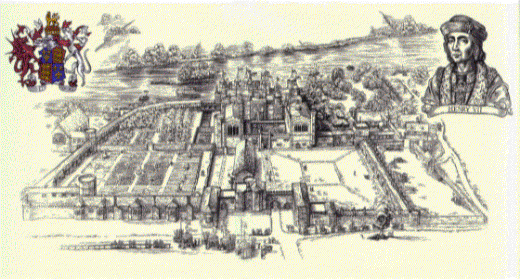Originally part of the Royal Manor of Kingston, Shene (with Kew) was formed into a separate manor by Henry I, who granted it to the Norman family of Belet. It remained in lay hands until the manor house was rented by Edward, Prince of Wales, in the 1290’s. The manor reverted to Crown ownership by 1313.
Edward I and Edward II used it occasionally, then it was granted to Queen Isabella, mother of Edward III. After her death, Edward III converted the manor house into the Palace of Shene, where he died in 1377.
It was the favourite home of his successor Richard II and Richard’s wife Anne of Bohemia. When Anne died there of the plague, in 1394, Richard was so heart-broken that he ordered the destruction of the Palace.
Henry V began the building of a new Palace in 1414, but this was not finally completed until the 1440’s in the reign of Henry VI. This second palace was extensively damaged by fire in December 1497 when Henry VII and his court had come to Shene for the Christmas season.
Henry VII, patron of the Renaissance arts, resolved to rebuild the Palace and in 1501 changed its name from Shene to Richmond after his earldom in Yorkshire. Occupying in its heyday an area of about 20 acres, the Palace extended from the Green to the river, and from approximately the line of the present Old Palace Lane to Water Lane. It assumed the appearance accurately recorded by Wyngaerde in 1561-2.
The Palace attracted many courtly attendants and the trade necessary to support a vast household. Richmond’s royal patronage influenced the nobility and the wealthy to look to the place for their out-of-town residences. The village which grew up around the palace also took the name Richmond.
Henry VII died in his new Palace in 1509, and Henry VIII made full use of it until he acquired the larger and even grander Hampton Court Palace from Cardinal Wolsey. The Palace in history was given to Anne of Cleves as part of her divorce settlement, but she gave it back to Edward VI.
Queen Mary spent her honeymoon with Philip of Spain in the Palace in 1557. Nearly half a century later Queen Elizabeth I, who made much use of The Palace in history, especially at Christmas, died there in March 1603. Sir Robert Carey, a cousin of the Queen, carried the news from Richmond to King James VI in Scotland, to inform him of his succession to the English throne.
Under the Stuart monarchy Richmond became the seat of the new Prince of Wales. Prince Henry, eldest son of James I, had great plans for rebuilding, but died of fever in 1612 before they could be implemented. His brother Charles abandoned such ideas but, as King, formed the great new Richmond Park. The Palace was used mainly as a house for his children until the Civil War (1642~1651).
After the overthrow of the monarchy and the establishment of the Commonwealth in 1649, a detailed survey of the Palace was carried out by the Parliamentary Surveyors and, in 1650, the buildings were sold. The purchasers divided up the property. The main stone buildings, including the Chapel, the Hall and the great block of royal apartments by the river, were rapidly demolished. By 1660 all that remained was the outer Great Court, including the middle gate, and the Wardrobe, and the range of brick buildings along the wall facing the Green on either side of the Outer Gateway. A small part of these still remains, but much was redeveloped from the early 18th century onwards.
Of the original Tudor buildings facing the Green, only the gateway itself, the Palace Gatehouse, and a small part of the house called The Old Palace now remain. The front of the Wardrobe facing the Court is also mainly Tudor. Tudor Lodge and Tudor Place and Maids of Honour Row have replaced most of those on the east side of the gate; the Old Court House, Wentworth House and Garrick Close those on the west side.
The Museum of Richmond in the Old Town Hall has a detailed model of the Palace as it looked in 1562 based on the detailed drawings made by Antonis van Wyngaerde (the earliest known views of the Palace). The model puts into context what remains to be seen on the ground, and evokes well the great size and magnificence of the Palace of King Henry VII.
